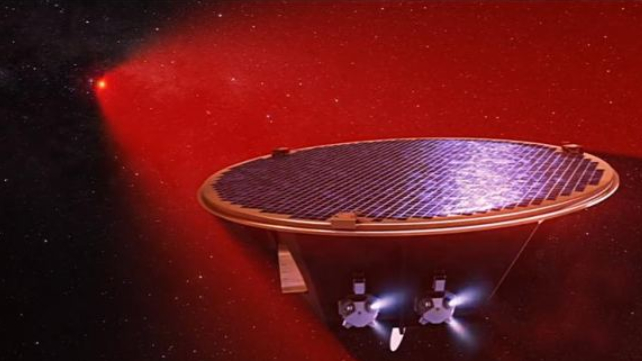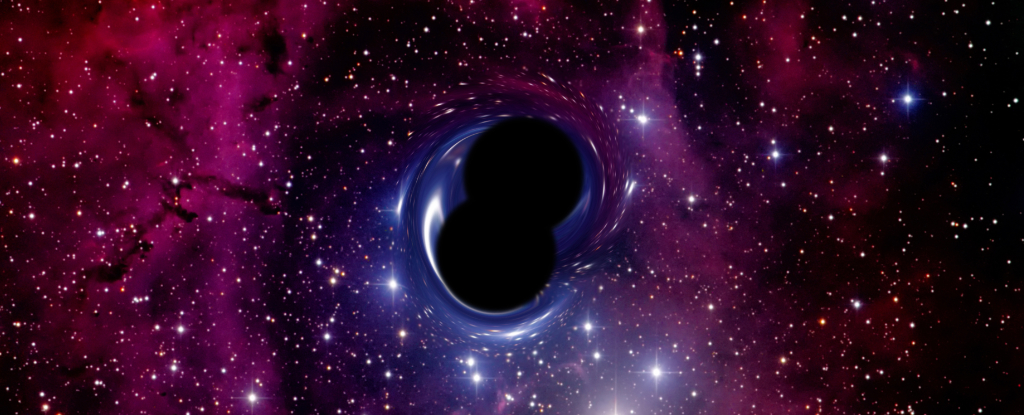Products You May Like
Galaxy collisions are foundational events in the Universe. They happen when two systems mingle stars in a cosmic dance.
They also cause spectacular mergers of supermassive black holes. The result is one very changed galaxy and a singular, ultra-massive black hole.
These colossal events are a major force in the evolution of galaxies. It’s how smaller galaxies combine to form ever-larger ones. Such mergers have been going on since the earliest epochs of cosmic time.
Galaxy mergers continue today. Our Milky Way continues to gobble up smaller ones and it will collide with the Andromeda Galaxy in a few billion years. When that happens, both galaxies’ supermassive black holes could also merge.
We don’t see the whole process from start to finish because it takes millions of years to complete. Yet, that doesn’t stop astronomers from looking for – and finding – evidence of galaxy and supermassive black-hole collisions.
The latest discovery used the Hubble Space Telescope (HST) to spot three bright, visible light ‘hot spots’ deep inside a pair of colliding galaxies. These targets lie relatively close to us – only about 800 million light-years away.
Astronomers followed up with Chandra observations and radio data from the Karl G. Jansky Very Large Array.
Typically, galaxies with bright cores, called active galactic nuclei (AGN for short), exist very far away. They’re often seen earlier in cosmic time. The chance to study a galaxy and a pair of supermassive black holes in a collision in the ‘modern’ nearby Universe is a good time to study the mechanics of such an event.
Spotting Incipient Supermassive Black Hole Collisions
The discovery of a future cosmic collision came when HST’s Advanced Camera for Surveys spotted three optical diffraction spikes in the heart of a colliding galaxy called MCG-03-34-64.
Two of those hot spots appear very close together – only about 300 light-years apart. They trace the presence of oxygen gas in the core. It’s being ionized by something very energetic and the hot spots surprised the astronomers. (The third hot spot isn’t well understood.)
“We were not expecting to see something like this,” said Anna Trindade Falcão of the Center for Astrophysics | Harvard & Smithsonian in Cambridge, Massachusetts. “This view is not a common occurrence in the nearby Universe, and told us there’s something else going on inside the galaxy.”

Falcão and her colleagues wanted to know what was going on to cause those bright spots. So, they used the Chandra X-ray observatory to focus on the action.
“When we looked at MCG-03-34-64 in the X-ray band, we saw two separated, powerful sources of high-energy emission coincident with the bright optical points of light seen with Hubble. We put these pieces together and concluded that we were likely looking at two closely spaced supermassive black holes,” said Falcão.
The team also found observations of these objects in archival radio telescope data. Those powerful radio emissions proved that the pair of black holes exists and are edging closer together.
“When you see bright light in optical, X-rays, and radio wavelengths, a lot of things can be ruled out, leaving the conclusion these can only be explained as close black holes,” noted Falcão. “When you put all the pieces together it gives you the picture of the AGN duo.”
The Upcoming Collision
These central supermassive black holes will collide in perhaps a hundred million years.
Each is at the core of a single galaxy. As those galaxies draw ever closer together, the black holes in their hearts will start to interact. Eventually, they’ll merge in a powerful event, emitting gravitational waves as part of the process.
Astronomers suggest (via simulations and observations) that mergers of galaxies with supermassive black holes trigger a lot of activity. As the collisions proceed, interstellar gas flows toward the galactic centers.
It also gets compressed in other regions and both activities trigger bursts of star formation. Some gas also accretes onto those central supermassive black holes, causing increased emissions as material spirals through the accretion disk.
These mergers happen continually in the Universe. Models of galaxy evolution, coupled with observational evidence suggest that many AGNs at the hearts of galaxies experience mergers. Colliding supermassive black hole pairs within those AGNs also suggest that those black holes grow through mergers.
Supermassive Black Hole Collisions and Future Detections
Understanding the merger of close-together AGNs such as the ones seen in MCG MCG-03-34-64 offers a unique window into the final stages of what astronomers call SMBH binary coalescence.
Such events are and will continue to be a major way to measure the effects of these mergers. They’ll offer a rich field of study using observatories sensitive to light across the spectrum, as well as future gravitational wave detectors.

Those detections will require advanced versions of the Laser Interferometer Gravitational-Wave Observatory (LIGO), which made its first detections only a few years ago. Supermassive black hole merger-induced gravitational waves will be the target of future instruments such as LISA (short for Laser Interferometer Space Antenna).
It will deploy three space-based detectors millions of miles apart to capture the long-wavelength gravitational waves emitted when black hole behemoths like the ones in MCG-03-34-64 collide.
Since those mergers occur throughout the Universe, it’ll be a rich field of study that contributes greatly to our understanding of galaxy mergers as part of cosmic evolution.
This article was originally published by Universe Today. Read the original article.
